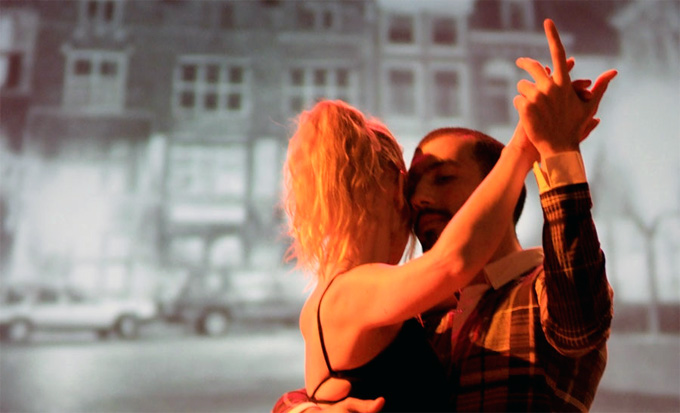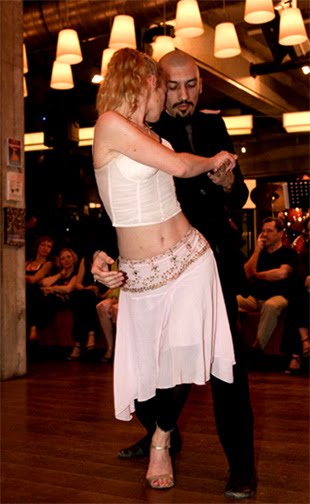 Being just back to Holland after a 3 months stay in Lisbon and because I’ve also been going back to my home country quite frequently since my emigration from Portugal I am often asked, in both places, how tango is in each of these places. My quick easy answer is: people in Portugal are shorter.
Being just back to Holland after a 3 months stay in Lisbon and because I’ve also been going back to my home country quite frequently since my emigration from Portugal I am often asked, in both places, how tango is in each of these places. My quick easy answer is: people in Portugal are shorter.
The long answer: Tango is universal, and so is being human. However, there are obvious differences; and finding the reason for them is sometimes difficult. Physically, it´s easy to point out some differences: Lisbon is magical; it is basically a big and monumental city that breathes people as a person would breathe air. Besides being the capital of a country almost 1000 years old which used to rule half of the world not so long ago(historical speaking), it receives every working day the same amount of people that it houses every night. There is a monument in every block, and I´m not solely talking about the inner city, and there’s actually the chance that you do live in a monument. So the first difference is simple: the context. There are so many quality places where milongas can happen while in Holland you don´t find places, you build them yourself. Thinking about outdoor milongas, then the difference is even bigger. On one side you have warm, dry weather, polished stone floors everywhere and an attitude of living in the public; on the other you have clouds, cold and rain, rough concrete pavements(at best red brick), the only few public spaces are parks and a law that prevents spontaneous gatherings of people. It´s hard to blame for these characteristics but this is my favourite side of tango dancing in Lisbon, anywhere you can dance and anywhere is insanely beautiful.
Another difference comes from geography, and this one goes in favour of Holland. I can actually speak of tango in the Netherlands while for Portugal I have to speak
 solely of Lisbon or Porto. It´s simply too far apart. Lisbon and Porto stand at over 300km apart and there is no tango in any nearby city or town. The Netherlands are the opposite. While every individual tango scene of every little city in Holland is way smaller than the one in Lisbon, you can travel to all these places as easy as going to the supermarket because they are close by and also well connected either by highways or public transportation. You can´t talk about a specific tango scene of a city in the Netherlands, you talk of a region. At any given milonga at a city you’re bound to meet people from other cities that also have their own tango school. In Lisbon, only people from the metropolitan Lisbon dance. This Dutch synergy between tango dancers makes for a very dynamic and strong tango economy. There are more students, and these dancers have to themselves a much bigger choice of dancing grounds; and this makes it so much more attractive for quality tango professionals to come to Holland to improve the general quality of the dancing and the general tango awareness of the public.
solely of Lisbon or Porto. It´s simply too far apart. Lisbon and Porto stand at over 300km apart and there is no tango in any nearby city or town. The Netherlands are the opposite. While every individual tango scene of every little city in Holland is way smaller than the one in Lisbon, you can travel to all these places as easy as going to the supermarket because they are close by and also well connected either by highways or public transportation. You can´t talk about a specific tango scene of a city in the Netherlands, you talk of a region. At any given milonga at a city you’re bound to meet people from other cities that also have their own tango school. In Lisbon, only people from the metropolitan Lisbon dance. This Dutch synergy between tango dancers makes for a very dynamic and strong tango economy. There are more students, and these dancers have to themselves a much bigger choice of dancing grounds; and this makes it so much more attractive for quality tango professionals to come to Holland to improve the general quality of the dancing and the general tango awareness of the public.
Now for the subtle differences. There are more men at milongas in Lisbon than at milongas in Holland. The proportion of male/female students is the same reg
 ardless of the country; however, there is in Portugal a culture where men go out at night much more often than women. The outcome is that at a milonga in Lisbon is not unusual to have more men than women, something quite unbelievable in the Netherlands. This Portuguese cultural aspect leads also to the fact that men end up practicing more than women, leading this to provide with a bigger quantity of higher quality male dancers than female ones. Another difference is seen in the age group: traditionally in Portugal, nightly and physical activities are done by youngsters. Tango fits in this profile and so the average age of Portuguese tangueros is younger than of their Dutch counterparts.
ardless of the country; however, there is in Portugal a culture where men go out at night much more often than women. The outcome is that at a milonga in Lisbon is not unusual to have more men than women, something quite unbelievable in the Netherlands. This Portuguese cultural aspect leads also to the fact that men end up practicing more than women, leading this to provide with a bigger quantity of higher quality male dancers than female ones. Another difference is seen in the age group: traditionally in Portugal, nightly and physical activities are done by youngsters. Tango fits in this profile and so the average age of Portuguese tangueros is younger than of their Dutch counterparts.
And what about in the milongas themselves? Technically, there is little difference. Comparing to the Netherlands, there is in Portugal: a much bigger preference (almost total) towards dancing only in close embrace; There is no difference regarding the use of “cabeceo” in order to ask someone to dance, both rarely use it; upon hearing the "cortina", both dancers immediately go each separate ways; there is a preference towards small steps and few big movements which is quite the opposite of Holland; the atmosphere is much more formal and serious; beginners don’t go to milongas; dancing to whatever music except traditional recordings of old tango music is frowned upon.

The most annoying aspect for me regarding the Lisbon tango scene is that, even though there are milongas almost every day, these same milongas don’t share the dancers they created and act a bit like rival clubs which does not help the evolution and enlargement of the tango scene in Lisbon. While in Holland there is a big group of people that go dance almost everywhere, in Lisbon these people are very few and not encouraged to do so.
All the photos are from some of my favorite dancing spots in Lisbon.









No comments:
Post a Comment